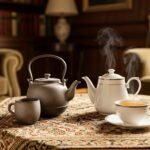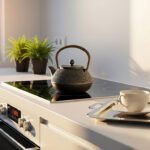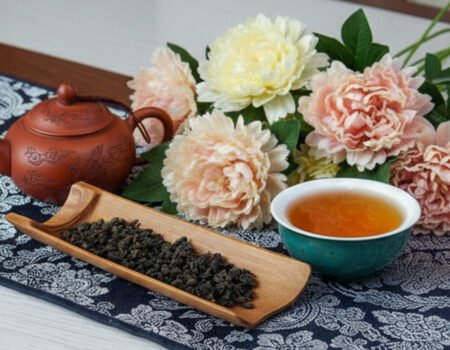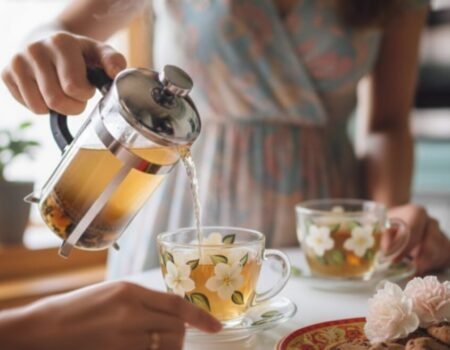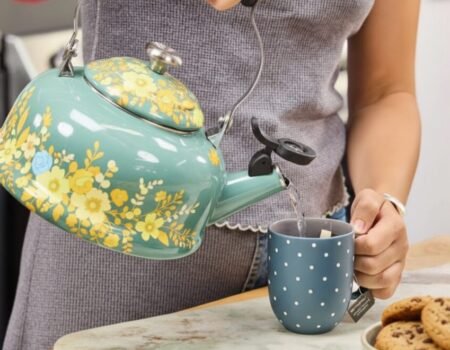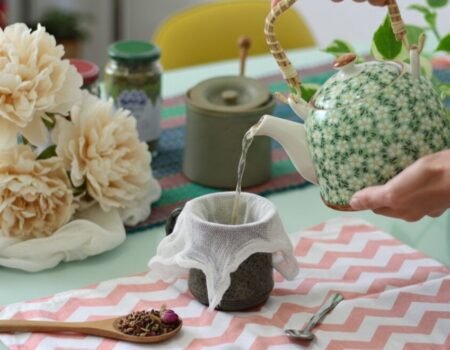
The Ultimate Guide to Tea Strainers and Infusers for Loose Leaf Tea
Index
Index
Brewing loose leaf tea can turn into a messy affair without the right tools to catch those floating leaves. Tea strainers and infusers are essential items that keep leaves contained while allowing their flavors to blend with water.
This guide will walk you through the best options for straining loose tea, from basic mesh balls to fancy basket infusers.
Key Takeaways
- Tea strainers filter leaves after brewing, while infusers hold leaves during steeping.
- Mesh size matters greatly – fine mesh works for small particles, while larger holes suit whole leaf teas.
- Quality materials make a difference – stainless steel resists rust and won’t affect flavor.
- Basket infusers give tea leaves more room to expand, creating better flavor than cramped tea balls.
- Different brewing styles need specific tools – Western pot brewing uses different strainers than Gongfu Cha ceremonies.
Defining the Tea Strainer

Tea strainers serve as essential tools for filtering loose tea leaves from your brew after steeping. These simple devices catch the leaves as you pour tea from pot to cup, keeping your drink smooth and free of debris.
Core Function in Loose Leaf Tea Brewing
Tea strainers serve as essential filtration tools that separate loose tea leaves from your brewed drink. They allow water to flow freely through a mesh or perforated surface while keeping the leaves contained, preventing unwanted bits from ending up in your cup.
Most quality strainers feature stainless steel mesh construction that resists staining and withstands regular use without affecting tea flavor.
The primary job of these devices differs slightly from infusers, though many use the terms interchangeably. Strainers typically sit between the teapot and teacup during pouring, catching leaves after steeping has finished.
This filtration process works particularly well for whole leaf teas that need space to expand fully during brewing, leading to better flavor extraction compared to cramped tea bags or ball infusers.
Distinction from Tea Infusers

Tea strainers and infusers serve different purposes in the tea brewing process. Strainers act as filters, removing leaves from already brewed tea as you pour it into your cup. They typically rest on top of teacups or sit between the teapot and cup during pouring.
Infusers, on the other hand, hold the loose tea leaves during the steeping process. They come in various designs like balls, baskets, and spoons that allow tea leaves to expand fully while brewing.
This expansion is crucial for proper flavor extraction from your loose-leaf tea.
The mesh size differs between these two tools based on their functions. Strainers often feature finer mesh to catch even the smallest tea particles, ensuring a smooth final drink. Tea infusers may have larger openings in their mesh depending on the tea type they’re designed for.
Your choice between a strainer or infuser will impact both the brewing method and the resulting flavor profile of your tea. The characteristics of tea strainers make them unique tools in the loose leaf brewing process.
Characteristics of Tea Infusers
Tea strainers come in many shapes and sizes to match your brewing style. Mesh size matters most when you brew fine teas or herbs that might slip through larger holes.
Typical Method of Use (Hand-Held)

Hand-held tea infusers offer a simple way to brew loose leaf tea directly in your cup. You place tea leaves inside the infuser, then submerge it in hot water for the desired steeping time.
Most hand-held options feature a handle that stays above the water line, allowing easy removal once brewing finishes. Popular styles include tea balls, which open like a locket to hold leaves, and silicone infusers that come in fun shapes.
For best results, larger mesh infusers give tea leaves more room to expand and release flavor. The mesh size matters greatly, especially with fine teas that might escape through larger holes.
High-quality stainless steel mesh tea infusers resist rust and won’t affect taste, unlike some lower-grade silicone versions that may impart a plastic flavor to your brew. Your choice of hand-held infuser should match both your tea type and personal brewing style.
Common Materials (e.g., Bamboo)

Beyond their hand-held design, tea strainers come in various materials to suit different brewing needs. Traditional strainers often feature bamboo construction, prized for its natural beauty and lightweight properties that complement tea ceremonies.
Modern options now include stainless steel, which has become a popular choice due to its durability and heat-resistant qualities. Many tea enthusiasts prefer stainless steel for its rust resistance and food-safe properties.
Silicone has emerged as another excellent material for tea infusers, offering flexibility and fun shapes while withstanding high temperatures and for those seeking eco-friendly options, ceramic and glass strainers provide great brewing experiences.
Mesh quality matters greatly across all materials – fine mesh tea strainers work best for smaller tea leaves and herbal blends, while larger perforations suit whole-leaf teas like oolong.
Each material brings unique benefits to your brewing process, affecting both function and the overall tea experience.
Importance of Mesh Size, Especially for Herbal Teas

Mesh size plays a critical role in brewing perfect herbal teas. Wider mesh allows tea leaves to expand fully during steeping, which releases more flavor compounds and healthy polyphenols into your cup.
Tea basket infusers stand out as the top choice for serious tea drinkers because they provide ample space for loose leaves to unfurl completely. Many tea balls fail to deliver optimal taste because their tight mesh restricts leaf expansion.
The right mesh size transforms an ordinary cup into a rich, flavorful experience.
Silicone tea infusers with small holes often compromise steeping quality despite their cute designs. The mesh openings must match your tea type – fine mesh works for powdery teas while larger openings suit whole leaf varieties.
Herbal teas contain various plant materials that need proper room to release their essential oils and medicinal properties. A quality stainless steel strainer with appropriate mesh size makes all the difference in extracting maximum benefits from your loose leaf tea.
Tea strainers also serve unique functions in different brewing traditions around the world.
Tea Strainers in Different Brewing Practices
Tea strainers play distinct roles across global brewing methods, from casual Western pot brewing to formal Eastern ceremonies. Different cultures have shaped unique strainer designs that match their tea traditions and brewing goals.
Role in Western Style Teapot Brewing

Tea strainers play a vital role in Western-style brewing, where loose leaves steep freely in a teapot before being strained into cups. This method allows tea leaves to fully expand in the pot, releasing more beneficial compounds and creating richer flavors than pre-packaged tea bags.
Many tea enthusiasts prefer stainless steel tea strainers for this purpose because they’re durable and don’t affect the tea’s taste.
The mesh size of your strainer matters greatly in Western brewing. Fine mesh tea strainers catch smaller particles from delicate teas like white or green varieties. Basket-style infusers work best for larger teapots, giving leaves ample space to unfurl.
Some tea lovers place a mesh strainer directly over each cup, catching leaves as they pour from pot to cup—a simple yet effective approach that honors traditional brewing methods while making cleanup easy.
Use in Gongfu Cha Ceremonies

Unlike Western brewing methods, Gongfu Cha ceremonies demand specific tea strainer use. This traditional Chinese preparation method dates back to the Song Dynasty in Chaozhou and requires precise straining techniques.
The fine mesh tea strainers serve a crucial role in filtering small leaf particles from oolong, pu-erh, and certain black teas during the multiple short infusions typical of Gongfu brewing.
Strainers with drip trays become essential tools in the complete Chinese tea ceremony set, working alongside teapots, gaiwans, and fairness pitchers. The stainless steel tea filters must capture even the finest tea leaves while allowing the full flavor to develop.
Many tea enthusiasts prefer extra-fine mesh tea strainers specifically designed for this ceremonial practice where each step honors the art, skill, and effort signified by the term “Gongfu” itself.
Conclusion

Tea strainers and infusers transform your loose leaf brewing from basic to brilliant. Each type serves a special purpose, whether you prefer the fine mesh needed for delicate white teas or sturdy baskets for bold black varieties.
Quality matters too—304 stainless steel options last longer and won’t rust like cheaper alternatives. Your perfect cup awaits with the right tools, whether that’s a simple ball infuser for solo drinking or a large basket for sharing with friends.
Choose wisely, and you’ll taste the full magic that loose leaf tea offers every time you brew.
FAQs
1. What is the difference between a tea strainer and a tea infuser?
A tea strainer filters out loose tea leaves after brewing, while a tea infuser holds the leaves during the brewing process. Tea infusers come in many forms like mesh balls, baskets, or tea filter bags that contain the tea leaf while allowing water to flow through.
2. How do I choose the best tea infuser for loose leaf tea?
Look for extra-fine mesh tea strainers made from 304 stainless steel for durability and clean taste. The right infuser depends on your tea cup size and the type of loose tea you brew.
3. Can I use the same tea infuser for different types of tea?
Yes, but clean your stainless steel tea diffuser thoroughly between uses to prevent flavor mixing. Some teas with fine leaves need extra-fine mesh tea balls filter infusers to stop leaves from escaping.
4. How do I clean my stainless steel tea infuser?
Rinse your tea infuser basket under hot water after each use. For deeper cleaning, soak in hot water with sodium bicarbonate, scrub gently, and ensure it’s completely dry before storing.
5. What are the benefits of using a tea infuser with a handle?
A steel tea infuser with handle makes it easier to remove from hot water without burning your fingers. Many models like the OXO brew twisting tea ball infuser include features such as a drip bowl or lid for added convenience.
6. How much loose leaf tea should I put in my infuser?
Use about one teaspoon of loose tea per cup, but adjust based on the amount of tea and personal taste preferences. Make sure not to overfill your mesh stainless steel tea ball as the leaves need room to expand during brewing.
References
- https://redblossomtea.com/blogs/red-blossom-blog/the-ultimate-guide-to-tea-infusers?srsltid=AfmBOopKFkkWXvEA34sxHeuYaoaLHtFjuaMsj4v_CPACvhdXl2LxMu0C
- https://www.firebellytea.com/blogs/all/tea-steepers-and-infusers?srsltid=AfmBOorRjYrd_-4B75lSasHKfeM6x0H09_pmWlOoM2HMvk2zaT0T2zUB
- https://senchateabar.com/blogs/blog/tea-infuser?srsltid=AfmBOor-B_1GC2-ebo0t3IJllEely7AqaCKpqPjGcc0F0pPR7QXPaTsB
- https://www.firebellytea.com/blogs/all/tea-steepers-and-infusers?srsltid=AfmBOorTrHTKwkGalVNep5G-iDLzrkz5fV7inl5zrXbqFq_eQGEB8gks
- https://senchateabar.com/blogs/blog/tea-infuser?srsltid=AfmBOooRj4KUzYfebs1oxQC7kRnfedLOQS3JXWOgXUF91VW6q0SW-P47
- https://www.firebellytea.com/blogs/all/tea-steepers-and-infusers?srsltid=AfmBOoq7SIKxHGypqtuFEqd2B3iOGq62JcCx1cArKJBzu2G5NOADVp48
- https://www.firebellytea.com/blogs/all/tea-steepers-and-infusers?srsltid=AfmBOoriwWXGHMVsLx6ZVGtsgUD77cx-fHndeuJ_bVmJcmMhxhyBIsKy
- https://redblossomtea.com/blogs/red-blossom-blog/the-ultimate-guide-to-tea-infusers?srsltid=AfmBOoqDYW7sD8SOga5uK-jUbY2mKToemjiNQW6u5S_geMLQQss59CzQ (2020-04-28)
- https://www.teasenz.com/chinese-tea/gongfu-tea-ceremony.html?srsltid=AfmBOorHEDpUWdri_vB4flPCQsYHB6e98S925aszsDfC2fYnec9vE-Mq
- https://www.teasenz.com/chinese-tea/21-step-gongfu-tea-ceremony.html?srsltid=AfmBOopInQyjzx3y0yaCVJd6jHElWYqO3vgxSpxpRoq5UJYIwVL6FSLd

